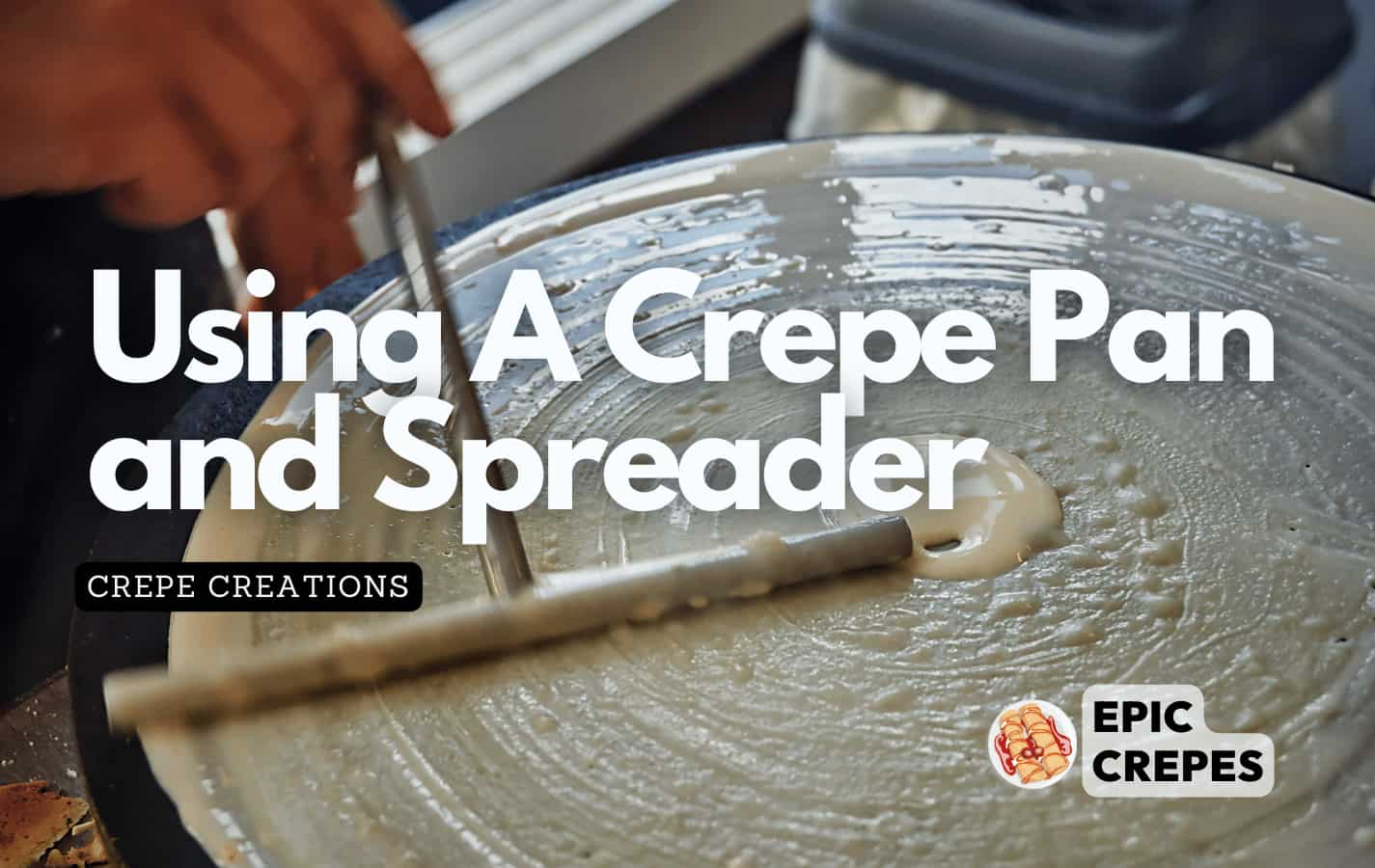If you love crepes but are intimidated by the thought of making them, fear not! With the right tools and a little bit of practice, anyone can become a master crepe maker.
The two essential tools you’ll need are a crepe pan and a spreader. In this article, we’ll go over everything you need to know about using these tools to create perfect, thin, and delicious crepes every time.
First, let’s talk about the crepe pan. This specialized frying pan is designed to heat evenly and maintain a consistent temperature throughout cooking. It should be non-stick, so your crepes don’t stick to the bottom of the pan, and have low sides to make it easy to slide the spatula under the delicate crepes.
Next up is the spreader. This tool helps ensure that your batter is distributed evenly across the surface of the pan, resulting in thin and uniform crepes. In this article, we’ll cover how to use both of these essential tools for perfect crepes every time.
Choosing The Right Crepe Pan
Are you looking to make the perfect crepes at home? The first step is choosing the right crepe pan.
While some people swear by non-stick options, others argue that cast iron pans are superior.
Non-stick pans have the advantage of being easy to clean and require little oil or butter for cooking. However, they may not get as hot as cast iron pans, which can result in uneven cooking.
Cast iron pans, on the other hand, can withstand high heat and distribute it evenly, making for perfectly cooked crepes every time.
Ultimately, the choice between non-stick and cast iron comes down to personal preference. Consider your cooking style and needs before making a decision.
Once you’ve chosen your pan, it’s time to move on to preparing your crepe batter.
Preparing Your Crepe Batter
Now that you have chosen the perfect crepe pan for your culinary adventures, it’s time to move on to preparing your batter. Mixing techniques are vital in creating the perfect consistency for your crepes. It’s important to use a whisk or a blender when mixing your ingredients together.
Batter consistency is also essential when making crepes. If your batter is too thick, your crepes will be heavy and difficult to spread. On the other hand, if your batter is too thin, it will not hold its shape and may tear easily while cooking. A good rule of thumb is that the batter should be similar in consistency to heavy cream.
To achieve the perfect batter consistency, follow these steps:
- Start with room temperature ingredients.
- Whisk gently until all ingredients are combined.
- Let the mixture rest for at least 30 minutes before using.
Once you have achieved the ideal batter consistency, it’s time to move on to using the crepe spreader. This tool helps evenly distribute the batter on the pan and can be adjusted to create thin or thick crepes depending on personal preference.
With a little practice and patience, using a crepe pan and spreader can become second nature, allowing you to create delicious and impressive meals in no time!
Using The Crepe Spreader
To use the crepe spreader, first, you need to pour the batter onto your crepe pan. Spread it with a thin layer using a spatula. Once you have done this, pick up the crepe spreader and place it in the center of the pancake.
Techniques for using a crepe spreader vary from person to person. Some people like to swirl it around gently to ensure even coverage, while others prefer to use a back-and-forth motion. Whatever technique you choose, make sure that the batter is evenly distributed across the surface of the pan.
Maintenance is also essential when using a crepe spreader. After each use, clean it thoroughly with warm soapy water and let it dry completely before storing it away.
If there are any stubborn bits of batter stuck to the spreader, use a soft-bristled brush or a non-abrasive sponge to remove them gently.
Moving on to cooking and flipping your crepes, there are several tips and tricks that will help you achieve perfect results every time.
Cooking And Flipping Your Crepes
As you slide the batter onto the heated crepe pan, the aroma of cooking crepes wafts through the air. With a flick of your wrist, you deftly spread the batter using the specially designed crepe spreader.
As the edges begin to brown, it’s time to flip! Cooking techniques vary depending on personal preference and recipe variations. Some like their crepes lightly golden while others prefer them crispy and browned. To achieve your desired texture, adjust the heat accordingly and monitor closely while cooking. Remember to flip only once for optimal results.
Experiment with recipe variations such as savory fillings or sweet toppings for a delicious twist on this classic dish. Whether you’re serving them for breakfast or dessert, mastering the art of cooking and flipping your crepes is sure to impress your guests and tantalize their taste buds.
Frequently Asked Questions
How Do I Clean My Crepe Pan?
Cleaning your crepe pan is an important step in maintaining its quality and ensuring that it lasts for years to come.
To keep your pan in great condition, there are a few cleaning tips you should follow.
First, start by wiping off any excess batter or food residue with a paper towel or cloth.
Next, rinse the pan under running water and use a soft sponge or brush to gently scrub away any remaining debris.
Avoid using harsh chemicals or abrasive materials that could damage the non-stick coating.
Finally, dry the pan thoroughly before storing it away.
By following these maintenance suggestions, you can keep your crepe pan looking and performing like new!
Can I Use My Crepe Pan On An Induction Cooktop?
As the famous adage goes, ‘where there’s a will, there’s a way.’ And when it comes to using your crepe pan on an induction cooktop, there is indeed a way.
You’ll want to look for crepe pans that specifically state their induction compatibility, as not all pans are suitable for this alternative heating method.
But once you have the right pan in hand, you can use it just as you would on any other stovetop.
So don’t let your induction cooktop hold you back from enjoying delicious homemade crepes – instead, seek out a compatible pan and get cooking!
Can I Make Savory Crepes As Well As Sweet Crepes?
Yes, savory crepes are just as delicious as sweet ones!
There are countless savory crepe variations and fillings to choose from, including ham and cheese, spinach and feta, or even a classic chicken and mushroom.
To make savory crepes, simply omit the sugar from the batter recipe and add in any herbs or spices that complement your filling.
Get creative with your fillings by using cooked meats, vegetables, cheeses, or sauces.
A great tip is to cook your filling before adding it to the crepe so that it doesn’t make the batter too soggy.
With a little experimentation, you’ll have a variety of tasty savory crepes to enjoy any time of day!
How Long Should I Let My Crepe Batter Rest Before Using It?
Like a fine wine that needs to breathe, crepe batter should also be given time to rest before cooking. Allowing the batter to sit for at least 30 minutes allows the gluten to relax and the flavors to meld together, resulting in a smoother and tastier crepe.
For the best recipes, consider adding flavors such as herbs, spices, or even cheese to your batter. Once your batter is ready, it’s time to use your trusty crepe pan and spreader to create delicious sweet or savory crepes that will impress any palate.
Can I Use A Different Tool To Spread The Crepe Batter If I Don’t Have A Crepe Spreader?
If you don’t have a crepe spreader, don’t worry, there are other options.
One alternative is to use the back of a spoon or a small ladle to spread the batter evenly over the pan.
Another option is to tilt the pan in a circular motion, allowing the batter to spread naturally.
Whichever method you choose, be sure to practice your technique before moving on to your final crepes.
With practice, you’ll soon find that spreading without a spreader can be just as effective as using one.
Conclusion
In conclusion, using a crepe pan and spreader is not as difficult as it may seem. With a little practice and patience, you’ll be flipping perfect crepes in no time!
I highly recommend investing in a crepe spreader to ensure even distribution of batter on the pan. However, if you don’t have one, don’t worry! A ladle or the back of a spoon can do the job just fine.
Don’t let your fear of a new kitchen gadget hold you back from creating delicious meals. Embrace the challenge and let your inner chef shine.
Using a crepe pan and spreader may just become your new favorite cooking activity. So go ahead, whip up some savory or sweet crepes and impress your family and friends with your newfound culinary skills!




